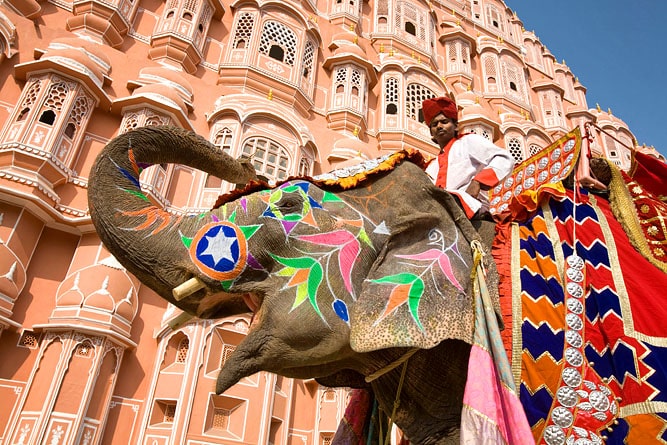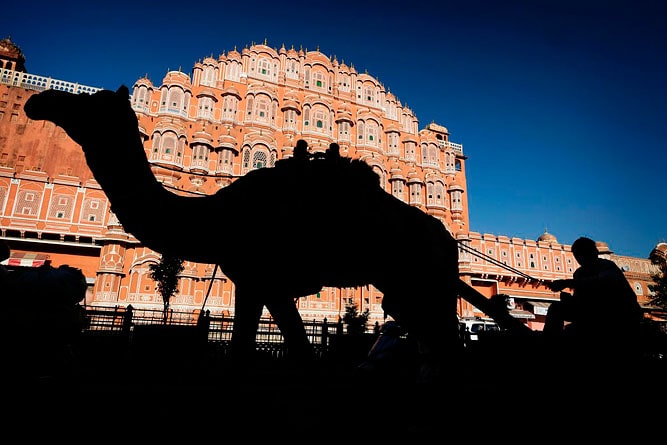Hawa Mahal (Palace of Winds)
Historical monument in Jaipur
must-see attraction
Opening hours: 9:00am-5:30pm
Address: Hawa Mahal Rd, Badi Choupad, J.D.A. Market, Pink City, Jaipur, Rajasthan
Ticket price: Indian/foreigner including camera ₹50/200, guide ₹200, audio guide ₹177
Visit duration: People typically spend up to 1.5 hours here
Website: www.hawa-mahal.com


About Hawa Mahal, Jaipur
A visit to Jaipur is incomplete without touring the exquisite example of Rajput-Mughal architectural excellence: the Hawa Mahal.
It is one of the most distinguished landmarks in Jaipur. Built with red and pink sandstone, the palace beautifully complements the other name of Jaipur - the Pink City. The interiors are made with white marble making it a striking contrast to the rosy exterior.
Hawa Mahal which translates to Palace of Winds or Wind Palace got its unique name from the tiny, 953 windows that were built in the structure to help passing of the wind. Being one of India’s hottest city, the palace was built as a summer resort for its royalty and the architects tried their best to make it pleasant.
History of Hawa Mahal
Hawa Mahal was built by Maharaja Sawai Pratap Singh, the grandson of Jaipur's founder Maharaja Sawai Jai Singh. It was completed in 1799.
A devotee of Lord Krishna, Maharaja wanted the shape of the monument to resemble Krishna's crown. That is what gave birth to the pyramidal shape of the 50-feet high Hawa Mahal.
The primary reason why the mahal was designed with so many small windows was to allow Rajpur ladies belonging to the royal family to get a glimpse of everyday life and festivities on the street. Since Rajput women were not allowed to appear in public without covering their faces, the windows of Hawa Mahal were their only way of connecting with everyday life.
The structure of the Hawa Mahal allows air to cool down as it blows into the palace. So, the building was also erected to offer a breezy area for the royal family during the summer months when temperatures were often very high.

Architecture of Hawa Mahal
Hawa Mahal stands as an example of a masterpiece when the Hindu Rajput style of architecture blends with the Islamic Mughal style. The fluted pillars, and floral patterns including lotus and domed canopies showcase the Rajput style of architecture. The Islamic style of architecture stands out in forms of intricate filigree work in stones and arches that resemble the ones at Panch Mahal at Fatehpur Sikri.
The front of the Hawa Mahal looks so beautiful from the outside that visitors often mistake it for the entrance. Quite interestingly, the Hawa Mahal does not have a front entrance and has to be entered from the side.
The monument does not have a foundation. In fact, it holds a record of being the tallest building in the world that has been constructed without a foundation. The curved shape of the monument has let it stand upright centuries after centuries.
Since the palace was used to escape the heat in summers, the construction is such that the inside of the palace feels breezy and cool all the time. The Venturi effect has been used to let the wind flow into the palace keeping it airy and comfortable even in the scorching heat.
The palace has five floors with the top three levels only as wide as a single room. The first and the second floors are larger with patios in the front.
The Hawa Mahal has been inspired by the design of the Khetri Mahal which was constructed around the 1770s.

Entry fee and timings
The Hawa Mahal is open on all days of the week, including public holidays. The monument opens at 9.00 am and closes at 5.30 pm.
The entry fee is different for Indian nationals and foreign tourists. While Indians have to pay ₹50, the entry fee for foreigners is ₹200. This fee includes camera charges.
You can visit all monuments in Rajasthan including the Hawa Mahal for free on Rajasthan Diwas (30 March). Other than that entry is also free on three other days: World Heritage Day dated 18 April, International Museum Day dated 18 May and World Tourism Day dated 27 September.
Facts and tips about Hawa Mahal
- Visit the Hawa Mahal in the morning so that you can hike up and reach the rooftop cafes that are in front of the monument. You can take some great photographs here as the Hawa Mahal looks beautiful when the rays of the sun fall on it.
- Since the City Palace and Jantar Mantar are very close to the Hawa Mahal, plan your visit in such a way that you can cover all three in a day.
- The Hawa Mahal is beautifully lit at night. Even though it closes at 5:30 pm, you can wait till sundown to click beautiful images of the palace at night. You can spend time shopping in the old market till the lights are on making Hawa Mahal look all the more regal.
How to reach Hawa Mahal
Hawa Mahal is situated in the heart of Jaipur. The monument is just near the City Palace, and Jantar Mantar is within 10 minutes walk.
See location on Google Maps
Other attractions near Hawa Mahal
- City Palace - 500m
- Jantar Mantar - 700m
- Albert Hall Museum - 1.9 km
- Amber Palace (Amer Fort) - 8.2 km
- Nahargarh Fort - 14.3 km
FAQs about Hawa Mahal
1. Why are there no stairs in the Hawa Mahal?
In spite of having 5 floors, there are no stairs. Instead of staircases, there are ramps that take you from one floor to another. The reason why the monument has ramps instead of stairs is that Rajput women belonging to royal families used to be carried in palanquins which were easier to move up the ramps rather than stairs.
2. What is the meaning of the Hawa Mahal?
The word 'Hawa' means winds and the word 'Mahal' means palace. So, the literal meaning of the Hawa Mahal is Palace of Winds.
3. How many windows are there in the Hawa Mahal?
There are a total of 953 latticed windows in the Hawa Mahal. These windows, called jharokhas, are very small in size and are adorned with intricate carvings.
4. What should I carry with me when visiting the Hawa Maha?
You can carry water bottles with you to keep yourself hydrated during the Hawa Mahal tour. Since you have to walk and climb stairs in the City Palace, it is recommended that you also wear comfortable shoes and cotton clothes, especially if you are visiting Jaipur in the summers.

